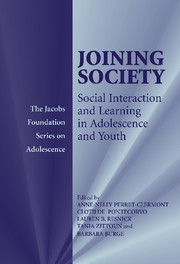Book contents
- Frontmatter
- Contents
- List of Contributors
- Foreword
- Preface
- I Introduction
- II Youth-Constructed Socialization
- III Personal Agency Through Collective Activity
- IV Learning in Practice and Discourse
- V Intergenerational Sites for Thinking
- 15 Thinking with Others: The Social Dimension of Learning in Families and Schools
- 16 The Role of Discourse in the Transformation of Parent–Adolescent Relationships
- 17 Interactive Minds: A Paradigm from Life Span Psychology
- 18 Thinking “Youth,” Thinking “School”: Social Representations and Fieldwork in Educational Research
- VI Pathways to Adulthood in National Context
- Index
- References
16 - The Role of Discourse in the Transformation of Parent–Adolescent Relationships
Published online by Cambridge University Press: 08 January 2010
- Frontmatter
- Contents
- List of Contributors
- Foreword
- Preface
- I Introduction
- II Youth-Constructed Socialization
- III Personal Agency Through Collective Activity
- IV Learning in Practice and Discourse
- V Intergenerational Sites for Thinking
- 15 Thinking with Others: The Social Dimension of Learning in Families and Schools
- 16 The Role of Discourse in the Transformation of Parent–Adolescent Relationships
- 17 Interactive Minds: A Paradigm from Life Span Psychology
- 18 Thinking “Youth,” Thinking “School”: Social Representations and Fieldwork in Educational Research
- VI Pathways to Adulthood in National Context
- Index
- References
Summary
The importance of verbal interaction is increasingly being recognized, particularly by social constructivists. However, the quantitative analysis of verbal exchange is not yet an established research paradigm. Research on discourse with older children, adolescents, and their parents has proved fruitful and has provided an impetus for the quantitative analysis of discourse. The research presented in this chapter draws on an approach that views discourse as a special kind of behavioral interaction. This chapter discusses why it is so important to examine discourse data in a quantitative way and then examines both conflict and planning discourse between parents and adolescents with several different coding systems. The use of multiple systems allows the examination of four specific questions. First, do patterns of parent–adolescent discourse differ from discourse patterns found in other relationships? Second, are the specific patterns of interaction that occur in discussions between parents and adolescents stable over different types of discourse? Third, can discourse help us to view the process by which individuation progresses within family relationships? Finally, are observed interaction patterns consistent with participants' subjective accounts of the interaction and relationship? The answers to these questions provide objective, generalizable evidence on the process by which adolescents and parents deal with the individuation process through everyday interactions.
The Individuation Theory Framework
The adolescent–parent relationship can be regarded as a prototypical situation for the study of discourse within a social-constructivist, individuation theory framework.
- Type
- Chapter
- Information
- Joining SocietySocial Interaction and Learning in Adolescence and Youth, pp. 241 - 251Publisher: Cambridge University PressPrint publication year: 2003



